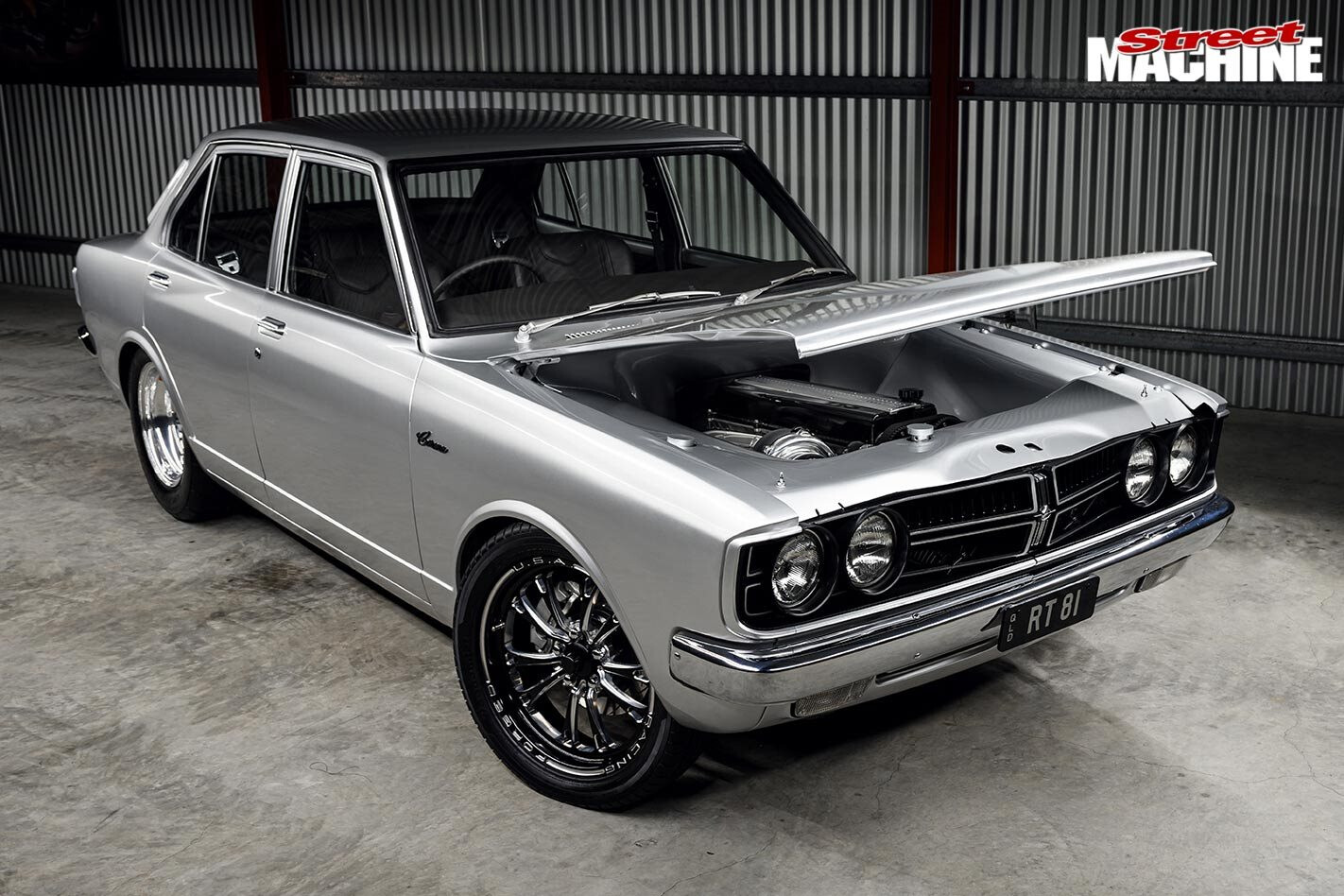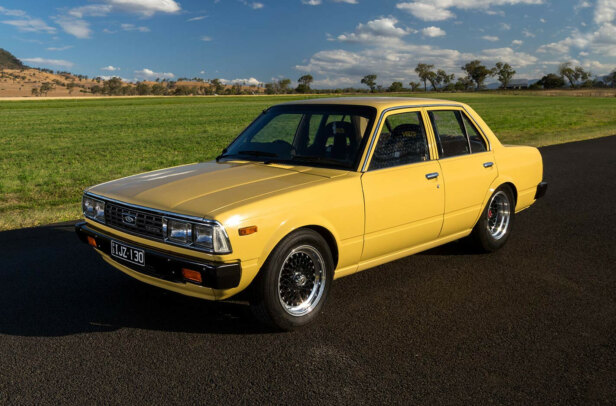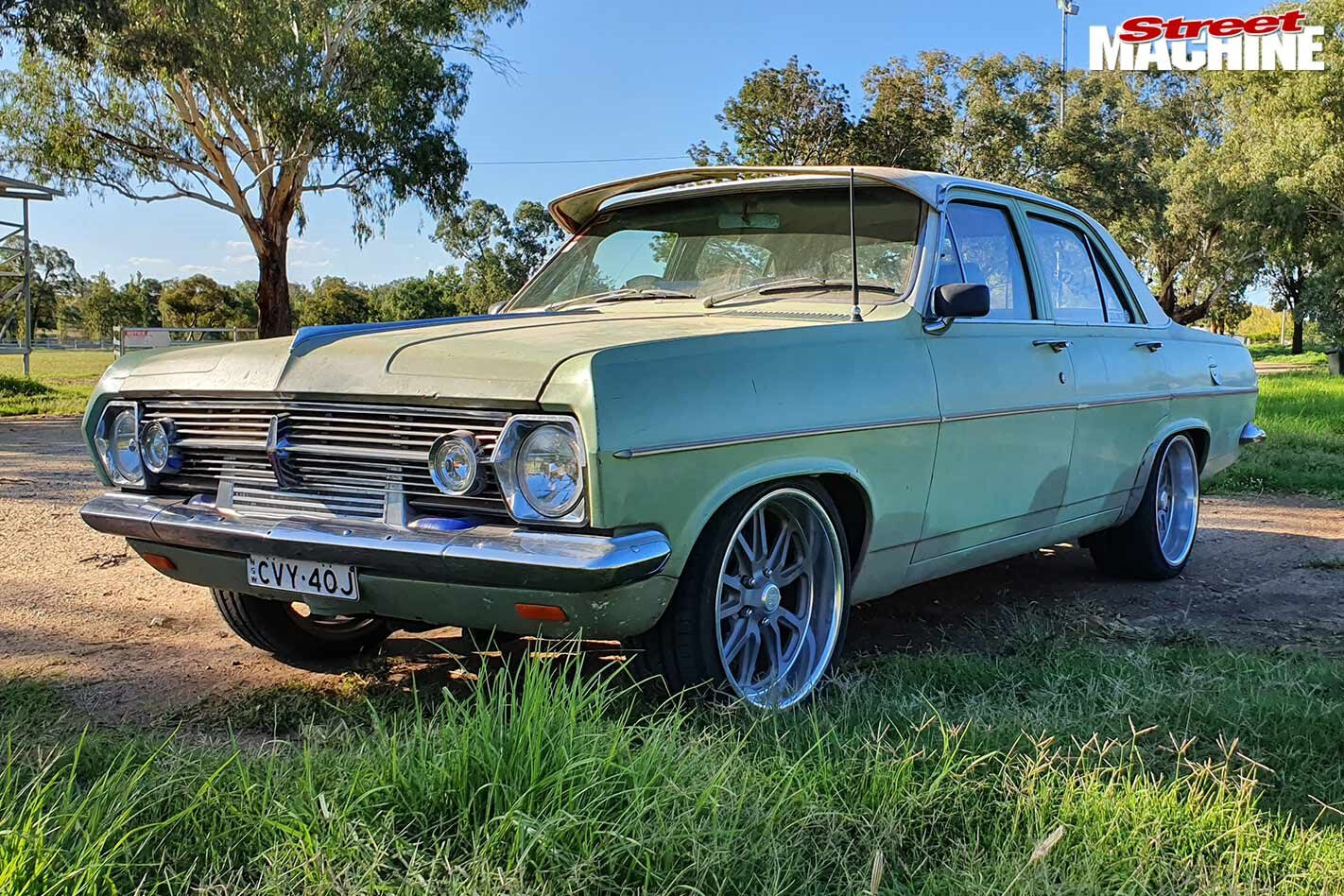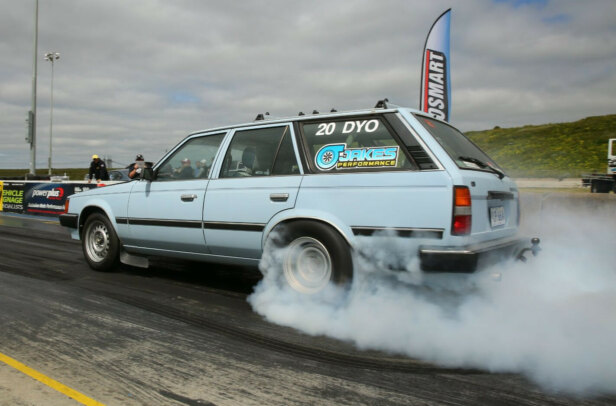THERE was an era when the Toyota Corona was more common than Winfield billboards and any virus this side of the Spanish flu, but it’s funny how time patches over your memory. ‘Outta sight, outta mind’, they say, because you never see Coronas of this vintage anymore. But you’ll only need a moment in the presence of this traffic-stopping ’73 Toyota rebuild to make you start chanting ‘Corona’ in the streets like a lunatic. And then possibly the police cells soon after.
This article was first published in the May 2020 issue of Street Machine
The 1970-74 RT80/81 Corona transitioned from bowls-club regular to underrated classic long ago, though it was always Toyota’s high point for Corona cred. Solid, refined and kinda stylish, all it was really crying out for was a serious spruce-up and an engine. Any engine. Just not a pushrod Toyota four.
With body prep by his old man, Nick, and silky silver paint from his own gun, Kieran’s Corona-on-crack manages to look both impressively detailed and encouragingly tough, which is just as well given what’s up front
Intriguingly, it was Kieran Robinson’s engine choice that steered him towards an RT81 Corona in the first place. He just wanted something to legally put a 1JZ turbo into, and Queensland’s regs confirmed that Toyota’s boosted 2.5-litre straight-six was indeed a sweet match for an early-70s Corona weighing roughly 950 kegs.
The drivetrain was rescued from a Commodore and returned to its rightful Toyota home, complete with mostly stock internals, but it’s been enhanced by a stout rebuild courtesy of Simon Thorogood and many weekends on the tools. A Haltech Elite 750 ECU, 89mm throttlebody and 1000cc Bosch injectors handle fuelling duties, while Camtech 282 cams, Hastings rings, ACL Race bearings, and Brian Crower valve springs with titanium retainers beef up the insides.
Layer upon layer of custom aluminium panelling hides the bits you don’t want to see, while a jewellery box full of carbonfibre and machined bits brings to life the 1JZ turbo the RT81 Corona has long been crying out for
As for the car itself, Kieran was prepared to schlep from Toowoomba to Sydney to check out an example of this now-scarce early Corona before a ’73 RT81 model in dog-shit brown popped up barely five minutes’ drive from home. Owned by a P-plater content with life in the slow lane, the Corona’s body was in near-perfect, rust-free condition – besides a few carpark dents – making its journey towards Top 60 Elite at Summernats 33 a much smoother ride.
In terms of the look, the Corona’s subtly hipped proportion speaks for itself. “I think the shape on its own is cool enough,” says Kieran, which is why he cleansed his Corona of most body adornments except for a few neat details. There’s a blacked-out ‘Corona’ script on the front guards (“otherwise no one would know what it is!”) and the original plastic grille with neat ‘C’ centre emblem, which really pops now that the back section is painted black.
With the grille and light surrounds coated in body colour (PPG Alfa Romeo Grigio Chiaro), the only chrome left on this Corona is the stock door handles, key locks, rain gutters and bumpers. Even the bonnet bulge is factory. And it looks hot!
Lift that bonnet, though, and it’s a whole new world. Paying respect to the Kindigit Process that Kieran greatly admires, the Corona’s engine bay is like a seamless jewellery box with an immaculate 1JZ proudly filling its centre, thanks to the firewall having its centre adjusted back by about 150mm to squeeze in six pots.
To keep the look super-clean, the fuel rail was shifted to beneath the CPC billet/carbonfibre intake, and there are custom-designed, hand-rolled aluminium infill panels to disguise the Plazmaman water-to-air intercooler, a pair of aluminium radiators, Wilwood master cylinder and even the wiper motor. The cam covers were hydro-dipped in carbon to match the intake manifold, and there’s a CNC-machined finish to everything aluminium.
Kieran retained the stock seat frames of his bucket-equipped ’73 Corona but junked the springs, meaning a full-foam formation that, from the integrated rear parcel shelf, appears as if it’s flowing like lava into shape
A custom-built manifold for the heavily modified Garrett T04E/75 turbo alludes to how much grunt this once-glacial Corona is now packing. With the tunnel lifted and floorpan modified to cop a fully manualised Toyota A340 four-speed auto (without compromising the Corona’s practicality), it transfers around 500 rear-wheel horsepower to chubby Mickey Thompson boots via a custom tailshaft and a shortened HiLux diff with 4.11 gears.
The stock-but-not interior strips away even some of the essentials to achieve its ‘retro concept-car’ look. Low-back seating and acres of kick-arse 1970s kalamata-olive colouring bring this Corona back to its youth
This super-sweet turbo-six Corona is capped off with ‘RT81’ plates – a neat homage to the underrated old stager buried deep beneath all those lustrous layers. Maybe ‘RT81’ should be the medical code for whatever cure-all injection manages to resuscitate humanity from its current unpleasantness! One thing’s for sure: If Kieran’s Corona drops into the 10s when it eventually hits the strip, that’ll extinguish more than just a couple of bugs.
BLAND DESIGNS?
BY THE time the RT80 Corona launched here in mid-1970, Toyota had been making cars in Oz for seven years and had earned a r neputation for rugged reliability. But never excitement. You still see and hear plenty about the iconic Datsun 1600 (1967-72). but Coronas of that vintage? Yeah, nah.
While the RT80/81 Corona (1970-74) was a big advance over its ‘shovel-nose’ predecessor, compared to the Datto’s buckets, front discs, overhead-cam donk and IRS, the ’Rona’s column change, front bench, pushrod engine and four-wheel drums were about as thrilling as a cruise ship reeking of virus-prone old grogans in bad leisure wear. Toyota sold plenty, but no one wanted to rally them, meaning no legacy beyond their use-by date and no compelling reason to keep them alive. And not so easy to get parts for now, as it turns out.
KIERAN ROBINSON
1973 TOYOTA CORONA SE
Paint: PPG Alfa Romeo Grigio Chiaro
ENGINE
Brand: Toyota 1JZ-GTE 2492cc straight six
Induction: EFI, 89mm throttlebody, 1000cc Bosch injectors
Inlet manifold: CPC billet/carbonfibre
Heads: Factory Toyota with ARP studs
Camshaft: Camtech, 282 degrees
Conrods: Factory
Pistons: Factory
Crank: Factory
Oil pump: Factory
Fuel system: Aeromotive Phantom Flex Stealth
Cooling: MX-5 radiators, two Maradyne 12in fans
Exhaust: Custom manifold, custom 3in stainless system and muffler
Ignition: Six LS-style coils
TRANSMISSION
Gearbox: Toyota A340 four-speed auto, fully manualised
Clutch: 3500rpm stall converter
Diff: Shortened HiLux diff, shortened Toyota axles, 4.11:1 gears, Eaton Truetrac
SUSPENSION & BRAKES
Front: King coil springs, Monroe shocks, nolathane bushes
Rear: Gazzard Bros Racing leaf springs, Monroe shocks, solid aluminium bushes
Brakes: Hopper Stoppers Big Brake kit, AUII Falcon calipers (f); 300mm EL Falcon discs, R31 Skyline calipers (r)
Master cylinder: Wilwood short
WHEELS & TYRES
Rims: Weld V-series 17×4.5 (f), Weld Vitesse 15×8 (r)
Rubber: Achilles ATR-K Economist 175/55R17 (f); Mickey Thompson ET 235/55R15 (r)
THANKS
Simon Thorogood for the nights and weekends spent building the engine; Nick Welch for setting up the ECU; my dad Nick for the countless hours sanding and prepping the body; Rod Nichols for stepping in the few days before Summernats 33 to get the door trims finished; Kristian, Jesse, Denver and Ben at Goleby’s Parts; Phil Keable at Bothwell Motors; Tony Martin at Motivated Turbos & Mechanicals; Scott Cortina at Gazzard Bros Racing; Michael Nicholls at Edge Automotive & Performance; Chris Anscombe at Digital Inserts & Evans Trim Shop (and special thanks for allowing me time off to finish the final touches); Darren Coleman at Windscreen Works; my family and friends who were a constant source of encouragement throughout the entire build




Comments